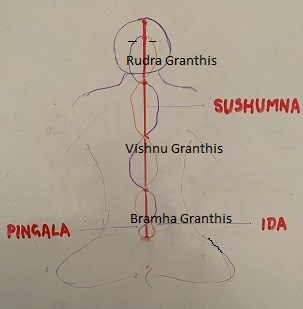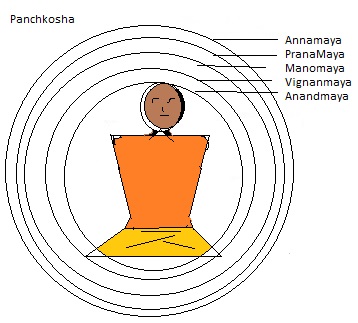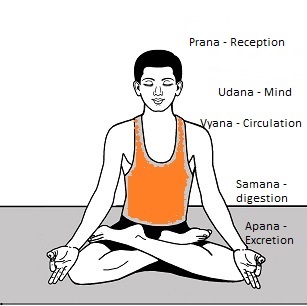 | Information published here is for reference purpose only. We recommend proper guidence should be taken from the trained authority for yogic practices. The purpose of compiling/listing/detailing these information here is for publishers and our practictioners quick references. Visitor of this page can use these information for reading purpose only.. |
Other reference Reading : YogaHome | YogAsana | YogaGyan | YogaMudra
| YogaSutra
| ShatKriya | YogaFor
In hindu beleif these are some basic classification of hindu texts.
Dharmic scriptures:
Vedas, Darshana, Purana, Agama, Itihas, Smriti.
Darshana further classified as Vedanta, Mimamsa, Sankhya, Yoga, Nyaya, Vaisheshika
Yoga further classfied mainly as Yoga Sutra, Gheranda Samhita,Hatha Yoga Pradipika, Siva Sutra ....
Patanjali's Yoga sutra has 196 sutras and are divided into 4 padas (chapter): The Yoga Sutras begin with Samadhi Pada (51 verses), which describes what yoga is; followed by Sadhana Pada (55 verses); and then Vibhuti Pada (56 verses), describing the benefits of yoga; and Kaivalya Pada (34 verses), explaining the concept of liberation or freedom from suffering.
Sankhya Yoga:Sankhya-Yoga is an ancient tradition, and one of the six major traditions of Hinduism. It is also one of the paths of yoga described in the yogic text, the Bhagavad Gita, where it is explained as the path of correctly discerning the principles or tattva of existence. Ref youtube video the relation of Samkhya yog and yoga philosophy.
The dualistic theory of creation or causation is called Sankhya Philosophy and it appears in texts as ancient as the Upanishads and the Bhagavad Gita. Its founder was the sage Kapila who is considered by scholars to be older than Buddha. It is also the theory of creation recognized by both Yoga and Ayurveda. Sankhya-yoga is a practice that combines the activities of the body and the soul. It is a form of devotional Yoga or Bhakti Yoga. The goal of Sankhya-yoga is to achieve union with the Supreme being. Through this practice, we can become more aware of our spiritual nature. Understanding the concept of Sankhya as Purusha and Prakriti, and studying its elements in detail can help practitioners reach a deeper level of awareness in their holistic yoga practice.
Another school of thought is the Yoga which seeks the union of God (Param) and soul (Atma) by means of meditation and various physical as well as mental disciplines.
Tattva
Tattvas are the basic concepts to understand the nature of absolute, the souls and the universe in Samkhya and Shaivite philosophies. Samkhya philosophy lists 25 tattvas while later Shaivite philosophies extend the number to 36. Tattvas are used to explain the structure and origin of the Universe.
Parabhramha ->Purush, Prakruti.
Prakruti-> Avyakta, Vyakta
Vyakta-> Mahat Buddhi -> Aham Kaar -> Aham Kaar +Satva, Aham Kaar+Tama
Aham Kaar +Satva -> Organs of Senses, Action of Senses
Organs of Senses ->Eyes, Ears, Nose, Tongue, Skin
Action of Senses -> Hands, Feet, Voice, Organs of excretion, Organs of reproduction
Aham Kaar+Tama->Panchbhoot, Tan Mantra
Panchbhoot->Aakash, Vayu, Tej, Aap, Pruthvi
Tan-Matra->Shabda, Sparsh, Roop, Rasa, Gandh
The five basic tattvas are earth, water, fire, air and sky. Each have corresponding symbols and colors. They also have corresponding chakras: earth is associated with muladhara, water is associated with svadisthana, fire is associated with manipura , air with anahata and sky with visuddha.
| Granthi (Psychic “Knots”)
- The Granthis are psycho emotional knots that are housed along
the Shushumna Nadi and correlate with the seven main chakras along the
central nerve channel. Brahma, Vishnu, and Rudra are the three
Granthi's. These knots prevent the life force from freely flowing.There
are many tantra yoga kriyas or
practices to pierce each knot. They are permutations of pranayama,
meditation, asana, mudras, and mantras. These practices must coincide
with a healthy lifestyle, proper diet, and following Yama and Niyama. Bandhas
are inner body locks that engage both the physical and the energetic
body. They provide inner support during asana practice, stimulate the
flow of prana and help to release the granthis, which can be understood
as energy blockages or psychological knots. According to the yogic tradition, a granthi (“knot”) is an energetic and psychic contraction preventing the free flow of prana (energy) along sushumna nadi (the main energy channel in the subtle body). The granthis impede the awakening of the chakras and the rising of kundalini shakti (the fundamental force of our being, generally lying dormant in muladhara chakra). In order for kundalini to achieve its final upward movement to sahasrara, it must first pierce through each of the three granthis (Brahma, Vishnu, and Rudra). These three psychic knots are located at the level of muladhara, anahata, and ajna chakras. |  |
Avastha
Avastha is state or stage, in yoga it is a state of mind. In general 3 known avasthas are waking (Jagrat), dreaming (Swapna) & deep sleep(Sushupti). There are also four known avasthas of a Siddha yogi on his path of yoga: the arambha (initial) avastha, ghata (second) avastha, parichaya (third) avastha and nishpatti (fourth) avastha.
Some of the names of Avasthas: Sahaj, Turya, Unmani, Manonmani
Purushartha Purushartha can be translated as the “object of human pursuit” or “purpose of human beings.” The four ultimate goals of purushartha are believed to be necessary for a happy and fulfilling life. In simple terms, artha is equated with money, kama with pleasure, dharma with duty and moksha with death. Artha and kama refer to the goals that humans are naturally inclined to seek, whereas dharma and moksha are considered to be of greatest importance to spiritual growth. Chaturvidh Purushartha:Dharma, Artha, Kama, Moksha Chatur Ashramas: Bhramhacharya, Grihasta, Vanaprastha, Sanyasa PanchaKlesha(Mental afflictions): Avidyaa (Ignorance), Asmita(ego), Raaga(attraction), Dwesha(repulsion), Abinivesha(urge to live at any cost). With these 5 kleshas we are born into human life. Through Yoga we can understand how these control our life and see their effects on our behaviour.These 'Kleshas' hinder our personal and social life and must be destroyed through the practice of Patanjali's Kriya Yoga consisting of Tapas, Swadyaya and Ishwar Pranidhana (Atman Prasadhanam). These are the root cause of stress and by tackling them head on we can distress effectively. Chitta Bhumi: Yogic states of consciousness as per Patanjali teaching, these are 5 states of mind. Kshipta (distracted) - Monkey Mind, Mudha (dull)-Donkey Mind, Vikshipta (partially focused)-Butterfly Mind, Ekagra (one-pointed)-Cane Mind, and Niruddha (completely controlled)-Mastered Mind. Chitta Vritti: Generally we can consider the vrittis as types of thoughts but they are broader than that. There are five main fluctuations that affect our outer consciousness: Correct knowledge (pramana), Incorrect knowledge (viparyaya), Imagination or fantasy (vikalpa), Sleep (nidra), Memory (smrti). Chatur Bhavana: The four attitudes that Patanjali advises us to cultivate are given in the 33rd Sutra of the Samadhi Pada. These attitudes that help us to control our mental processes are: friendliness towards those who are happy (Maitri – Sukha); compassion towards those who are miserable (Karuna – Dukha); cheerfulness towards the virtuous (Mudhita – Punya); and indifference towards the wicked (Upekshanam – Apunya). These help us create a Yogic attitude of Sama Bhava or equal mindedness in all situations. They also help us to overcome the Kleshas, and provide us with answers on how to live a Yogic life. They make us humane and help us to live within the social structure in a healthy and happy manner. Samatvam: Development of a complete personality neither affected by praise nor blame through development of Vairagya (detachment) leads to the state of "Stitha Prajna" or "Sama Bhava". Karma Karma refers to actions or deeds, in the past, present and future. Karma includes physical as well as mental or psychological acts. In the yoga world, there are three types of karma. Sanchitta, Prarbdha, Agami All these three aspects of karma blend into each other. “As you think so shall you be” – our choices and actions of the present moment will become our karma in the future. A clock to remember:
|
AshtaGuna (Virtues):
The eight gunas or qualities are : daya, ksanti, anasuya, saucha, anayasa, mangala, akarpanya, aspruha.
What are those eight virtues?
Daya – Compassion. Universal Love. This is Loving Kindness to all creatures
Kshanti – Tolerance, patience. This is towards those who do not follow dharma.
Anasuya – lack of jealousy. This is towards those who are better than us. Also called mudita in Buddhism.
Sowcha – Inner purity. Virtuous thought, speech and action
Anaayasa – calm in action. In Buddhism, this is samatta
Mangala – Pure and majestic joy.
Akaarpanya – Generous in giving. Dana.
Aspruha – unattached (to worldly and impermanent things)
Siddhi (Supernatural powers):
Siddhis can be translated as perfection or accomplishment. All religions accept the phenomenon of supernatural powers.
Eight main powers acquired by a spiritual person as listed in the Indian scriptures are Aṇimā, Mahima, Garima, Laghima, Prāpti, Prākāmya, Iṣhaṭva, Vasatva.
These are the most discussed yogic powers.
Anima - becaming small like atom, Mahima - becaming great, like akash (space), Garima - Being light but ability to became very heavy, Laghima - small or light, ability to became very light, Prapti - ability to acquire anything anywhere, Prakamya - ability to obtain anything desired, Ishatva - Power of absolute lordship over entire creation, Vasatva - ability to have everything under control, especially the physical manifestation made up of 5 elements.
Lord Hanuman ji has these siddhis as per context depicted in various incidents in Hindu Mythological scripts.
Nidhis (devine treasures) are:
Mahapadma: Great lotus flower , Padma: Lotus/ a Himalayan lake with treasures
Shankha: Conch shell, Makara: Crocodile/ Antimony
Kachchhapa: Tortoise or turtle shell , Mukunda: Cinnabar/ Quick Silver
Kunda: Jasmine/ Arsenic , Nila: Sapphire/ Antimony , Kharva: Cups, vessels baked in fire
Rudras:
According to the legend Brahma asked Rudra to create some other beings as he was bored of creating simple mortals.
It is said that Shiva created 11 forms of Rudra. They are called Kapali, Pingala, Bhima, Virupaksa, Vilohita, Ajesha, Shasana, Shasta, Shambhu, Chanda and Bhav.
The18 Puranas names (with shlokas count):
Bramha(10000), Padma(55000), Vishnu(23000), Shiv(24000), Shrimadbhagwat(18000), Bhavishya(14500), Naarad(25000), Warah(24000), Linga(11000), Bramha Waivart(18000), Kurma(17000), Matsya(14000), Waman(10000), Skanda(81100), Markandeya(9000), Garuda(19000), Bramhanda(12000), Agni (15400).
The concept of 33 Koti Gods(Devata):
The number 33 comes from the number of Vedic gods explained by Yajnavalkya in Brhadaranyaka Upanishad –
They are: 8-Vasu, 11-Rudra, and 12-Aaditya, 1-Indra and 1-Prajaapati. (Chapter I, hymn 9, verse 2)
Sum Total of it is 33
8. Vasus are ~ Earth, Water, Fire, Air, Ether, Moon, Sun, and Star. They are called Vasus, because they are abode of all that lives, moves or exists. (also mentioned in Mahabharat, 1/66/18)
11. Rudras ~ The ten Pranas (Praana, Apaana, Vyaana, Samaana, Udaana, Naag, Kurma, Krikal, Devadutta and Dhananjaya) i.e. nervauric forces which live in the human body. The eleventh is the human soul. These are called ‘Rudras’ because when they desert the body, it becomes dead and the relations of the deceased, consequently, begin to weep.
Rudra means one who makes a person to weep. { also mentioned in Harivansha 13/51-52})
12. Adityaas —the twelve months of a year called Adityaas, they cause the lapse of the term of existence of each object or being. (also mentioned in Mahabharat). Anshuman, Aryaman, Indra, tvashta, Dhnu, Parjanya, Poosha, Bhaga, Mitra, Varun, Vaivasvata, Vishnu. These names are varied in differnet puranas but basics of about are same.
1. Indra which is also known as the (all-pervading) electricity, as it is productive of great force.
1. Prajaapati, also called the “Yajna” because it benefits mankind by the purification of air, water, rain and vegetables and because it aids the development of various arts, and in it the honor is accorded to the learned and the wise.
The master of these 33 Devatas is the Mahadeva or Ishwar who alone is to be worshipped as per 14th Kanda of Shatpath Brahman.
Yoga is nothing else but a science of awareness. Do how much you can for others. A life lived for others gives happiness.
So we have duty towards our near and dear and then towards our work.
So we have duty towards our near and dear and then towards our work.

